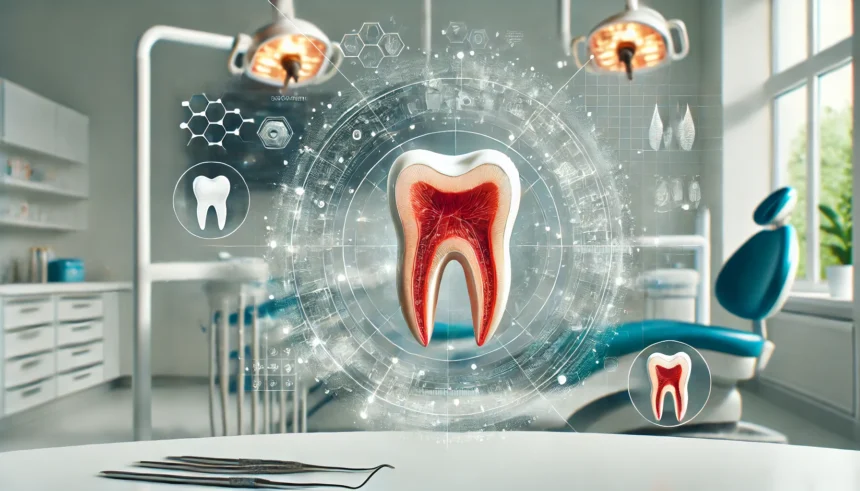Tooth extractions are a common dental procedure, but the healing process that follows is just as important as the extraction itself. Proper care and understanding of what’s normal can ensure a smooth recovery and prevent complications. This article will guide you through the healing process, care tips, and what to watch for during recovery to ensure healing normal socket after tooth extraction is successful.
What Happens After a Tooth Extraction?
After a tooth is removed, your body immediately starts working to heal the socket, the hole left behind. The process involves several stages, all contributing to healing normal socket after tooth extraction:
- Blood Clot Formation: Within the first 24 hours, a blood clot forms in the socket. This clot protects the underlying bone and nerves while setting the stage for tissue regeneration.
- Tissue Regeneration: Over the next few days, granulation tissue begins to form, replacing the clot and promoting healing.
- Bone Healing: The jawbone gradually fills the socket, a process that can take several months.
The blood clot is crucial for protecting the socket and ensuring a healthy recovery. Disrupting it can lead to complications like dry socket and delay healing normal socket after tooth extraction.
Timeline of Healing a Normal Socket After Tooth Extraction
Day 1-2: Initial Recovery
- Expect mild bleeding, swelling, and discomfort.
- The blood clot forms, acting as a protective layer over the exposed area.
- Tips: Bite down on gauze to stop bleeding and use a cold compress to reduce swelling for healing normal socket after tooth extraction.
Day 3-7: Early Healing
- Swelling and pain start to subside.
- Granulation tissue begins forming, which may appear whitish or gray—this is normal during healing normal socket after tooth extraction.
- Tips: Continue gentle rinsing with warm salt water to keep the area clean.
Week 2-4: Gum Tissue Recovery
- The gum tissue starts to close over the socket.
- Most discomfort should be gone by this stage, signifying progress in healing normal socket after tooth extraction.
- Tips: Gradually return to regular activities and a normal diet.
4-6 Weeks: Bone Recovery
- The bone begins filling in the socket. While this phase may not be visible, it’s essential for long-term oral health and healing normal socket after tooth extraction.
- Full bone healing can take several months.
How to Care for the Socket Post-Extraction
Proper care during recovery can make all the difference in healing normal socket after tooth extraction:
Do’s:
- Rest and keep your head elevated to reduce swelling.
- Use cold compresses for the first 24 hours and switch to warm compresses afterward.
- Maintain oral hygiene by brushing carefully around the extraction site and rinsing with warm salt water (mix ½ teaspoon of salt in 8 ounces of water).
Don’ts:
- Avoid smoking, spitting, or using straws for at least 48-72 hours to prevent dislodging the blood clot and hindering healing normal socket after tooth extraction.
- Don’t touch or poke the socket with your tongue or fingers.
- Steer clear of strenuous activities for the first few days.
Foods to Eat and Avoid During Healing
Recommended Foods:
- Soft and cool options like yogurt, smoothies, mashed potatoes, applesauce, and soup to support healing normal socket after tooth extraction.
- Foods that are easy to chew and won’t irritate the socket.
Foods to Avoid:
- Hot, spicy, or crunchy foods that can disturb the clot.
- Sticky or chewy foods that can get lodged in the socket.
- Carbonated and alcoholic drinks that might irritate the area.
Gradually reintroduce harder foods as your healing progresses for healing normal socket after tooth extraction.
Signs of Normal Healing
Healing normal socket after tooth extraction can look different for everyone, but common signs of normal recovery include:
- Gradual reduction in pain and swelling.
- Formation of white or grayish tissue in the socket (granulation tissue).
- Gums slowly closing over the extraction site.
If these signs are present, your recovery is likely on track for healing normal socket after tooth extraction.
Warning Signs and When to Contact Your Dentist
Sometimes, complications can arise. Contact your dentist if you notice:
- Dry Socket Symptoms: Severe, throbbing pain a few days after the extraction, accompanied by a bad taste or smell, which can delay healing normal socket after tooth extraction.
- Signs of Infection: Fever, excessive swelling, redness, or pus in the socket.
- Other Concerns: Difficulty swallowing, breathing, or persistent bleeding.
Prompt dental care can address these issues before they worsen and support healing normal socket after tooth extraction.
Long-Term Care and Recovery
After your initial healing, maintaining good oral hygiene and attending follow-up appointments are essential for healing normal socket after tooth extraction. Your dentist may recommend additional steps if you’re planning dental implants or other restorative procedures.
Conclusion
Healing a normal socket after tooth extraction is a straightforward process if you follow proper care guidelines. By understanding the stages of healing, adopting good habits, and knowing what to watch for, you can ensure a smooth recovery and successfully achieve healing normal socket after tooth extraction. If you have concerns or experience unusual symptoms, don’t hesitate to consult your dentist.
Frequently Asked Questions (FAQs)
What are the stages of healing normal socket after tooth extraction?
The healing stages include blood clot formation, tissue regeneration, and bone healing. The blood clot protects the area, while new tissue and bone develop over time.
How long does it take to heal normal socket after tooth extraction?
Gum tissue typically heals within 2-4 weeks, while full bone healing can take several months. Following proper care can speed up the process.
What foods help in healing normal socket after tooth extraction?
Soft and cool foods like yogurt, smoothies, and mashed potatoes support recovery. Avoid hot, spicy, or crunchy foods that can disrupt healing.
How can I prevent complications during healing normal socket after tooth extraction?
Avoid smoking, spitting, and using straws for at least 48-72 hours. Maintain oral hygiene by gently rinsing with salt water and keeping the area clean.
What are signs of complications in healing normal socket after tooth extraction?
Symptoms like severe pain, foul taste, swelling, or fever may indicate dry socket or infection. Contact your dentist immediately if these occur.
Recommended Article:
Comprehensive One Day Meal Plan for a Woman with Iron Deficiency: Boost Your Iron Naturally
The Importance of the Pinky Toe: Functions, Care, and Common Issues
Dr fernando cardiology alkaholik san diego shrev cardiology: Your Heart Health Experts






